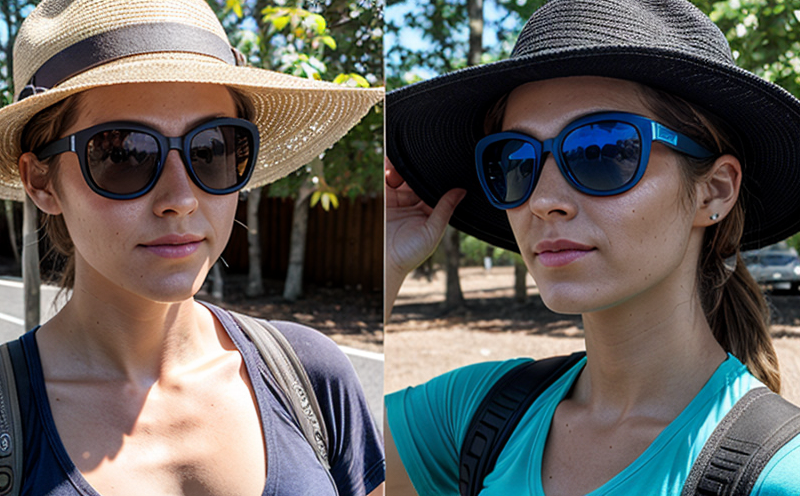JIS L1926 Testing of solar radiation transmission through fabrics
The JIS L1926 test method is a critical standard used to evaluate the ability of textiles to transmit solar radiation, particularly focusing on ultraviolet (UV) protection. This test provides essential data for manufacturers and designers who are concerned with the performance of their products in protecting against harmful UV rays. The standard outlines precise protocols that ensure accurate measurement and comparison across different fabric samples.
The methodology involves exposing a piece of woven or knitted fabric to artificial solar radiation under controlled conditions. The intensity and spectrum of this radiation simulate real-world sunlight, allowing for a realistic assessment of the fabric's protective capabilities. After exposure, the transmitted light is measured using specialized equipment, typically spectrophotometers or similar instruments.
The key parameter in JIS L1926 testing is the percentage of UV rays that penetrate through the fabric. This metric is crucial because it directly influences how much protection a garment offers to the wearer. A lower percentage indicates better UV protection, which is especially important for fabrics used in outdoor clothing or other applications where prolonged exposure to sunlight is expected.
The test setup involves several components, including a solar simulator that emits broadband light, a sample holder capable of maintaining consistent conditions during testing, and a spectrometer to measure the transmitted radiation. The entire process adheres strictly to ISO standards to ensure repeatability and accuracy across different laboratories and facilities.
Understanding the nuances of JIS L1926 is vital for industries like fashion, outdoor gear manufacturing, and even automotive textiles. Proper interpretation of test results can lead to enhanced product design, improved compliance with regulatory requirements, and better customer satisfaction by providing superior protection against UV damage.
The importance of this testing cannot be overstated, especially given the increasing awareness about environmental factors affecting human health. By leveraging JIS L1926 testing, manufacturers can ensure that their products meet stringent quality benchmarks, thereby enhancing consumer trust and loyalty.
In conclusion, JIS L1926 testing plays a pivotal role in safeguarding individuals from harmful UV radiation while promoting innovation within the textile industry. It is essential for any company looking to produce high-quality, safe, and effective protective fabrics.
Why It Matters
The JIS L1926 test is vital because it helps ensure that textiles provide adequate protection against harmful solar radiation. This is particularly important in regions with intense sunlight, where prolonged exposure can lead to skin damage and other health issues.
By measuring the transmission of UV rays through fabrics, this standard allows manufacturers to evaluate their products' effectiveness in blocking these potentially dangerous wavelengths. This information is crucial for meeting regulatory standards and enhancing product safety, which is essential for public health.
In addition to consumer protection, JIS L1926 testing also plays a role in sustainable development by encouraging the use of eco-friendly materials that offer superior UV protection. It supports innovation in fabric design and encourages companies to adopt practices that reduce environmental impact while maintaining high standards of quality.
The results from this test are widely recognized and accepted, making it easier for businesses to comply with international regulations and certifications. This consistency fosters trust among consumers and strengthens brand reputation.
In summary, JIS L1926 testing is more than just a technical procedure; it represents a commitment to safety, sustainability, and consumer welfare.
Why Choose This Test
Selecting the JIS L1926 test for evaluating solar radiation transmission through fabrics offers several advantages. Firstly, its stringent standards provide reliable data that can be trusted across various environments and applications. This consistency ensures accurate comparisons between different fabric samples, allowing manufacturers to make informed decisions based on objective criteria.
Moreover, compliance with JIS L1926 helps businesses meet international regulatory requirements, which is increasingly important in today's global market. By adhering to this standard, companies can ensure their products are safe and effective, thereby reducing the risk of legal challenges or recalls.
The test also supports research and development efforts by providing a benchmark against which new materials and designs can be evaluated. This enables continuous improvement in fabric technology, leading to safer, more durable, and environmentally friendly products.
Additionally, JIS L1926 testing fosters trust among consumers who are increasingly concerned about the environmental impact of their purchases. By demonstrating adherence to this standard, manufacturers can appeal to eco-conscious customers, potentially increasing market share and brand loyalty.
In summary, choosing JIS L1926 for solar radiation transmission testing offers robust data, regulatory compliance, innovation support, and enhanced consumer confidence, making it an attractive option for many industries.
Use Cases and Application Examples
JIS L1926 testing finds application in numerous sectors where protection against UV radiation is critical. For instance, in the fashion industry, this test ensures that clothing items like swimwear, sun hats, and outdoor wear meet strict safety standards. Similarly, it plays a significant role in the production of automotive textiles, ensuring that materials used in car interiors provide adequate UV protection.
In the medical sector, fabrics used for patient gowns or hospital bedding must pass rigorous JIS L1926 testing to prevent skin damage from prolonged exposure to sunlight. This is particularly important in environments where patients are confined to beds and spend significant time outdoors.
The outdoor recreation industry also benefits greatly from this test as it helps ensure that tents, backpacks, and other gear used by hikers, campers, and adventurers provide reliable UV protection. Consumers can trust that these products will keep them safe during extended periods spent under the sun.
Lastly, the agricultural sector uses JIS L1926 testing to evaluate protective covers for crops or livestock shelters, ensuring they block harmful UV rays while allowing necessary light for growth and development.
In each of these cases, JIS L1926 testing serves as a critical tool in safeguarding individuals from UV damage and promoting the use of high-quality, safe textiles across various applications.





